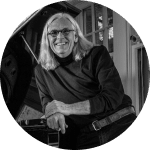

The creation of this work was a similar process to the creation of SWW 12 which was determined by the movement limitations of a ’40 loomed rope. With SWW 16 I had the vision, the urge, to create a solo with a cymbal. The problem was really one of how to make the cymbal an essential part of the dance.
The primary challenge was what to do about the sound for the piece. Would I have to play throughout to sustain the sound world, if not, would lots of silence drain the energy of the piece? Would I need to work with a recording of a solo cymbal piece – or would I need to ask a composer to create something? Even though the cymbal is suspended waist height at centre stage, and the dance moves consistently in relationship to it, I knew that I could not sustain a subtle or convincing musical performance. Composer Allan Gordon Bell’s solution was to create a sound score from recordings of the seven different strikes that I used during in the dance.
A secondary challenge dealt with bringing two vibrational/energetic conceits into a new whole:
In our bodies also, there are infinite sound vibrations on the different layers of consciousness, the permutations and combinations of which go to form this body. The ….yogis say that in the beginning there was only one sound and that sound was the sacred Om, and that later on, through its sound vibrations, the universe came into being.
Swami Satyananda Saraswati, The Dynamics of Yoga
The five elements are also known as the five processes of energy….In space, they regulate the motions of all the planets, stars, and suns. In nature, they promote interactions between the elements of fire, water, wood, metal, and earth. Within the human body they affect the five major organs (and associated mental, physical and emotional states)….
Lee Holden, Five-Element Qi Gong, A Manual for the Immersion Trainings
The complexity of these elements forms a rich territory. It wasn’t until we were in the theatre videoing the piece that I was beginning to sense where the piece could go. More work to do!
These short video clips show a variety of approaches to the cymbal and the movement.
I went through numerous stages – working with mallets, gloved hands, boxing wraps to protect the hands, improvising with Evelyn Glennie’s recorded cymbal performance of Allan Gordon Bell’s littoral-liminal, the cymbal either on a stand or hanging from a pipe and drape system, obvious or muted vocal expressions, exaggerated or subtle emotional expressions, an endless stream of options.
SWW 16 Sound and Dance Balance
Robin Tufts
At the very beginning of the SWW 16 process I was fortunate to have percussionist Robin Tufts guide me in an exploratory session with the cymbal. He gave me confidence to explore. The questions that Robin posed regarding my approach to the cymbal and the dance: Is the dance about the hands? Is it expression or discovery or both? Is the voice involved, with utterance or play? Is there surprise or intrigue or irritation or release? How do resonance, pulse, and vibration play a role? Does the sound draw you in or push you away? Robin guided my sound making by suggesting that I draw or pull sound out of the cymbal, and to find extremes – the beautiful and the ugly, the tender and the bombastic.
Sound and Dance Balance
It was clear to me that my cymbal playing would need to be limited to be effective musically. And on the other hand, as Rehearsal Director Helen Husak pointed out, the playing would also need to be substantial enough to make the cymbal necessary to the piece.
Allan Gordon Bell
Once I had determined seven different sounds that I would be able to play during the dance, Allan recorded these. He then created a sound score through the manipulation of these sounds that would respond to and support significant quality changes in the dance. Ultimately there were several layers of sound to the work – my cymbal strikes, voice, breath and floor sounds, and Allan’s sound score.
To glean satisfaction from the performance experience of SWW 16 I must stay connected to the cymbal. Whether touching it, looking at it, listening to it, or moving in its space, the cymbal is a partner. The more that dynamic is at the heart of the dance, the more the piece reveals its mystery.
In observing the initial work- in-progress of SWW #16 it was clear that there were more opportunities to further draw out the sensitive and curious relationship developing between the performer and cymbal. “A stronger beginning”, was one rehearsal note quickly scratched on paper during a viewing. The choreographer’s solution: As the opening to the work, the performer strikes the cymbal in darkness (a simple, strong rhythmic pattern), allowing the aural resonance to fill the space. The lights and soundtrack come up to reveal the performer’s body in relation to the cymbal (ear leaned in toward cymbal) the vibration permeating the cellular matrix of the performer’s torso and arms, moving her into a specific physical and emotional state. A little further into the work, I made a note to stay more “intentional” and “longer in duration” with the walking fingers- as the fingers travelled from the performers’ body across the surface of the cymbal- to feel the magnetic pull and gravity of the cymbals’ surface- strengthening the connection between the two. Throughout the piece, the performer strikes the cymbal with varying intentionality- this was explored further with manipulating the speed, distance and quality of the strike. An example is at the very end of the piece where the performer, after several attempts, intentionally swipes the underneath surface of the cymbal with an uplifting resonance.
Helen Husak, Rehearsal Director
The costume designer for SWW, Angela Dale, was unfortunately not able to work with me on SWW 14, 16 or 17. During SWW 16 the repeated and sometimes aggressive cymbal strikes required a special solution to protect my hands. I tried gloves of different thicknesses but surprisingly these did not do the job. The boxing wraps offered a good solution in that the hands were protected, I could strike without reserve, and the fingers were free and visible allowing for delicate articulations in expression. The basic black for the T and pants was a nod to the classical music world where we see whole orchestras in black. It is difficult to see the body on the video, and I know Steve Isom worked on this during the shoot. The black might work in a live setting but I will reconsider the colour for the next performance opportunity.
When I first watched a rehearsal I could see in my mind, the cymbal just floating in air. Lighting the piece for me was about showing the cymbal and Davida in a void. I didn’t want see a pool of light or even peripheral elements like the floor and curtains. I wanted to augment the brass colour of the cymbal yet keep Davida focused and dimensional.
Top lights provided the colour on the cymbal and a range of white colour temperatures from sides, backs and front lit Davida. I found that the costume bottoms where not responding to light the same way as the top, so I needed to add more intensity and front fill until the bottoms became more visible and dimensional to the camera.
Steve Isom



Dance and Music Cues with Allan Bell’s Sound Score
00:00 Vibration Dance
0 – 28 slow build
28 – 46 quiet section with very soft 3 and 5 count phrases
46 – 1:00 7 count phrase and three progressively quieter 5 count phrases
1:00 Fear Dance
1:00 – 1:43 – Sustained tone a steady build
1:43 – 2:01 – diminishing sound
2’02 Pulse Dance
2:02 – 2:40 12 reiterations of note and pulse pattern (2 trios – 5,6,7/8,9,10)
2:40 – echo
2:44 – 1 pulse pattern
2:47 – echo STRIKE HERE BEFORE THE SCORE BELL CUES
2:51 – 2:58 – 3 light knocking bell cues
3:00 Worry Dance
3:00 – 3:34 – 4 Diminishing waves (3:00, 3:14, 3:24, 3:34)
3:47 – 3’53 – light knocking bell cues
3:53 – 4’19 – diminishing – on the body?
04:20 Finger Drumming
4:20 – 5:16 KEEP MOVING
5:17 – 5:28 4 light knocking bell cues
05:29 Stealth Dance
5:29 – 5:56 – 5 shifts and shimmers
5:57 – 6:01 – two knocks bell cues tight to Anger PATTERN FEB 9 TURN ON FIRST BELL
06:02 Angry Dance –
6:02 – 6:14 roar FIRST RISE
6:17 – 6:27 roar SECOND RISE, STRIKE, THIRD RISE, STRIKE 2 & 3, KICKING
6:44 – super roar BEGIN PUNCH DOWN
6:55 – super roar STAY AT END OF PUNCH DOWN TO SECOND
7:16, 7:24 – thunder and diminishment SECOND THUNDER BATTEMENT
7:44 – 7:51 – 3 quiet knocking bell cues
07:52 Sadness Dance –
7:52 – 8:00 transition VERY LOW DOWN IN
8:00 – 8:51- 5 isolated double light swishes and high distant tones SLOW REVOLVE W FOREARMS OPENING, SPINE CURVING SIDE
8:51 – 9:13 hang time REVOLVE ON SPOT
9:14 – 9:26 3 double swishes – TRY SINKING IN ROCK
9:27 – 9:31 – 2 knocking bell cues tight to Slippery Ground TURN FOCUS ON SPOT
09:32 Slippery Ground –
9:32, 9:37, 9:42 – 3 swipes – REACH OUT AND GO SLOW AT FIRST
9:43 – 9:55 – quiet lull
9:56 – swipe – MAKE CONTACT
10:06 – swipe – MAKE CONTACT
10:22 + Fade End